Hanoi, a city of captivating contrasts, where centuries-old temples sit alongside bustling modern life and the constant hum of scooters forms an urban symphony. Despite the seemingly chaotic flow of traffic that dominates its streets, navigating Hanoi on foot is surprisingly manageable. Vehicles seem to gracefully part, fanning out and flowing around pedestrians like a well-rehearsed dance, allowing you to reach your destination with limbs intact. For me, the real challenge lies in the enticing street food stalls, their large vats of bubbling soup and low plastic stools spilling onto narrow walkways, a delightful obstacle course threatening to trip you if you dare look away to snap a photo.
It was precisely these vibrant street-side scenes in the historic Old Quarter that we set out to explore and taste on a recent trip. A highlight was a private walking food tour, a dizzying three-hour journey led by a knowledgeable local guide. We hopped between various food stalls and small eateries – too many to count – sampling a diverse range of dishes. Each plate, each small bite, contributed to a satisfying and culturally stimulating feast.
Discover the Best Overnight Summer Camps in Texas
Your Ultimate Guide to Oktoberfest Los Angeles 2024
Discover the Best Things to See in Sarasota
The tour kicked off with a visit to a buzzing little restaurant known for its excellent Banh Xeo. Cooked fresh to order right at the entrance, this sizzling, crispy-edged rice pancake was generously filled with succulent prawns and crunchy beansprouts. The traditional way to enjoy it is by wrapping pieces in fresh rice paper along with a generous assortment of fragrant herbs, creating a perfect pocket of flavor and texture before dipping it into nuoc cham (fish sauce).
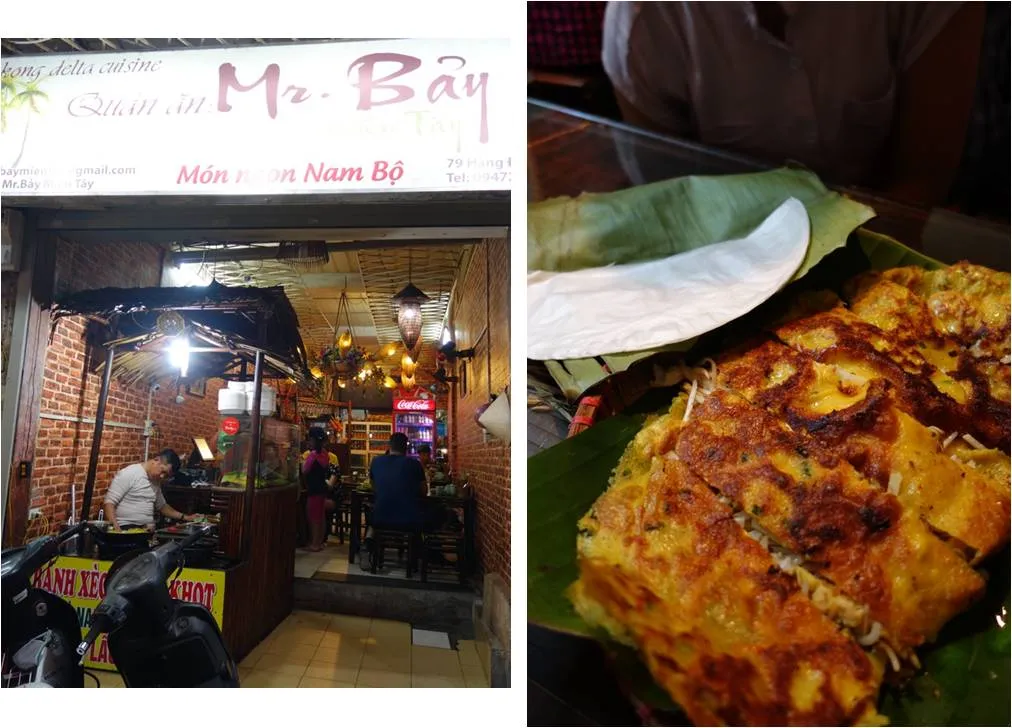
Crispy Banh Xeo pancake filled with prawns and beansprouts, served with fresh herbs and rice paper
Just next door, a cheerful young woman ran a delightful dessert stall that immediately caught our eye. We couldn’t resist trying her rice mochi balls, which were filled with peanuts. While similar in concept to desserts found elsewhere, these had a unique touch with a sprinkling of coconut shreds, adding a lovely tropical note that differed slightly from what we were used to.
Our culinary adventure continued as we moved on to another stop specializing in salad. This eatery, while perhaps lacking in conventional aesthetics, served one truly delectable dish: beef jerky salad with a fish sauce dressing. It was the only item on their menu, a testament to its popularity and focus. The salad combined the savory jerky with crisp green papaya, cucumbers, carrots, fresh coriander, mint, beansprouts, and peanuts, creating a medley of light, bright flavors and satisfyingly crunchy textures.
According to our guide, this salad spot was a popular pre-dinner destination. Locals would often stop by early in the evening for this refreshing and light bite before heading home or moving on to their main dinner venue. It’s a fascinating glimpse into the local dining habits and the role of street food in daily life.
We then ventured to a different restaurant known for offering more unusual dishes. Here, we sampled fried snakehead fish, a dish prepared with dill, beansprouts, and crisp fried onions. The engaging part was assembling it ourselves, wrapping moist pieces of the perfectly cooked fish in rice paper alongside fresh coriander, mint, and peanuts. The combination of the tender fish and aromatic herbs resulted in a complex and delightful flavor profile in every bite, offering a wonderful mix of textures.
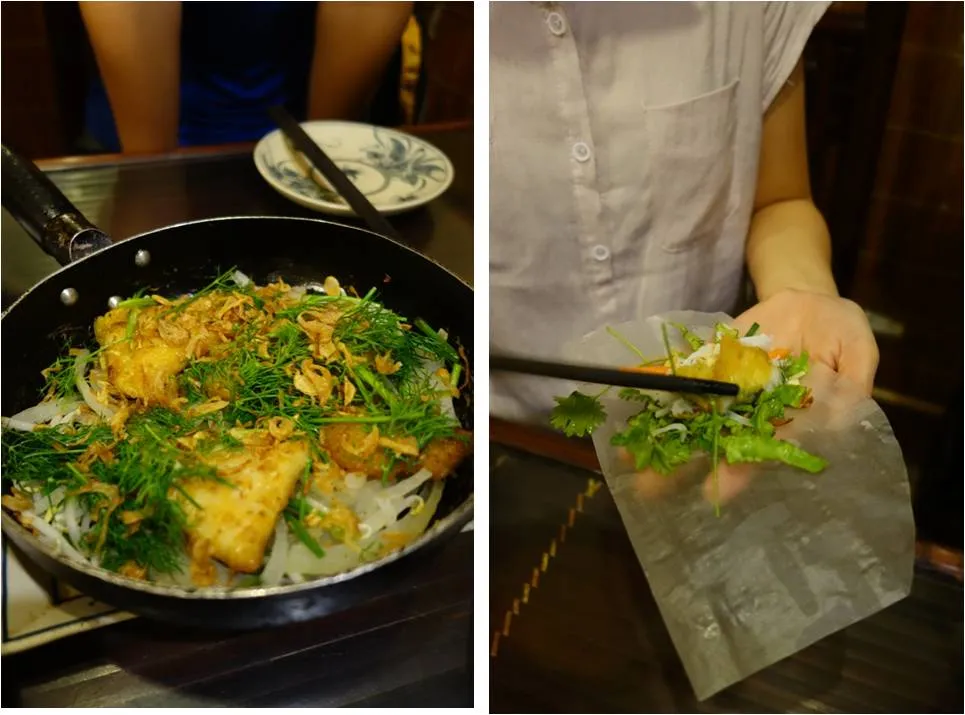 Close-up of fried snakehead fish pieces with dill, served with fresh herbs, noodles, and wrapping components
Close-up of fried snakehead fish pieces with dill, served with fresh herbs, noodles, and wrapping components
Another adventurous dish we tried at this stop was juicy, hearty fried frogs’ legs served with peppery betel leaves. This is certainly not a dish you find on every Vietnamese menu, making it a unique and memorable part of the Hanoi Walking Food Tour. It was surprisingly delicious and utterly more-ish.
We had planned to visit a particularly famous pho shop down the street, but the queue was exceptionally long, snaking far down the road. Our guide wisely decided to skip it and explore other options within the Old Quarter, which is brimming with culinary alternatives. While the replacement pho shop we visited wasn’t quite as renowned, it still offered a taste of this essential Vietnamese noodle soup.
The final stop on our Hanoi Walking Food Tour provided a sweet and fitting finale. It was a much-loved hole-in-the-wall dessert stall run by a cheerful aunty. Despite being packed, we managed to find some small plastic stools, squeezing them into the busiest part of the entrance. Without a table, we perched our metal trays of dessert on our laps, embracing the true street food experience.
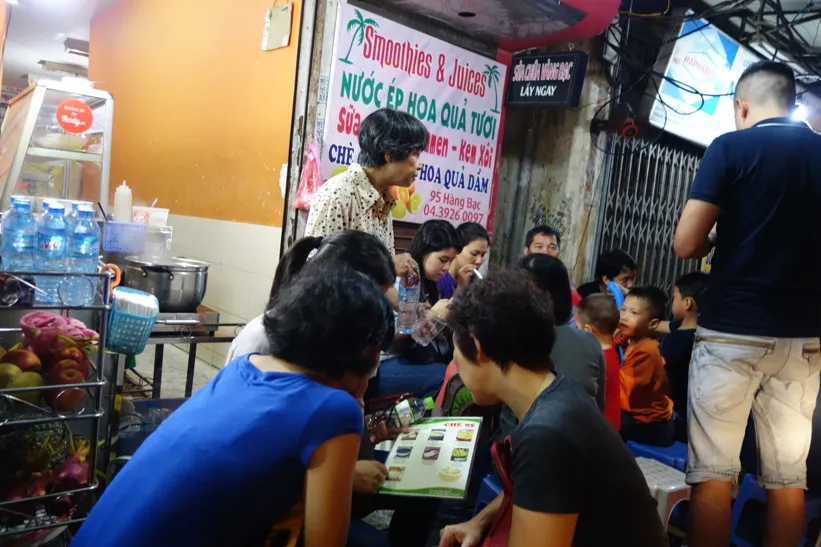 Small plastic stools and low tables crowded near the entrance of a dessert stall in Hanoi
Small plastic stools and low tables crowded near the entrance of a dessert stall in Hanoi
The desserts here were somewhat similar to those found in Singapore but with unique variations. We tried a creme caramel with black glutinous rice (akin to pulut hitam), which was quite good, though creme caramel isn’t typically my favorite. Surprisingly, a simple black bean soup with coconut milk, which sounded rather unexciting, was absolutely excellent. The soy ice cream served with glutinous rice was also incredibly enjoyable. These sweet treats marked the end of our immersive food tour. By the time we ambled back to our hotel, it was nearing 11 pm, our appetites fully satisfied and our minds buzzing with new tastes and experiences.
The Hanoi Walking Food Tour is more than just eating; it’s an intimate journey through the city’s culinary heart. It allows you to connect with the local culture, understand the rhythm of daily life in the Old Quarter, and discover hidden gems you might otherwise miss. Guides often share fascinating stories about the history of the dishes, the traditions behind them, and the families who have run these stalls for generations.
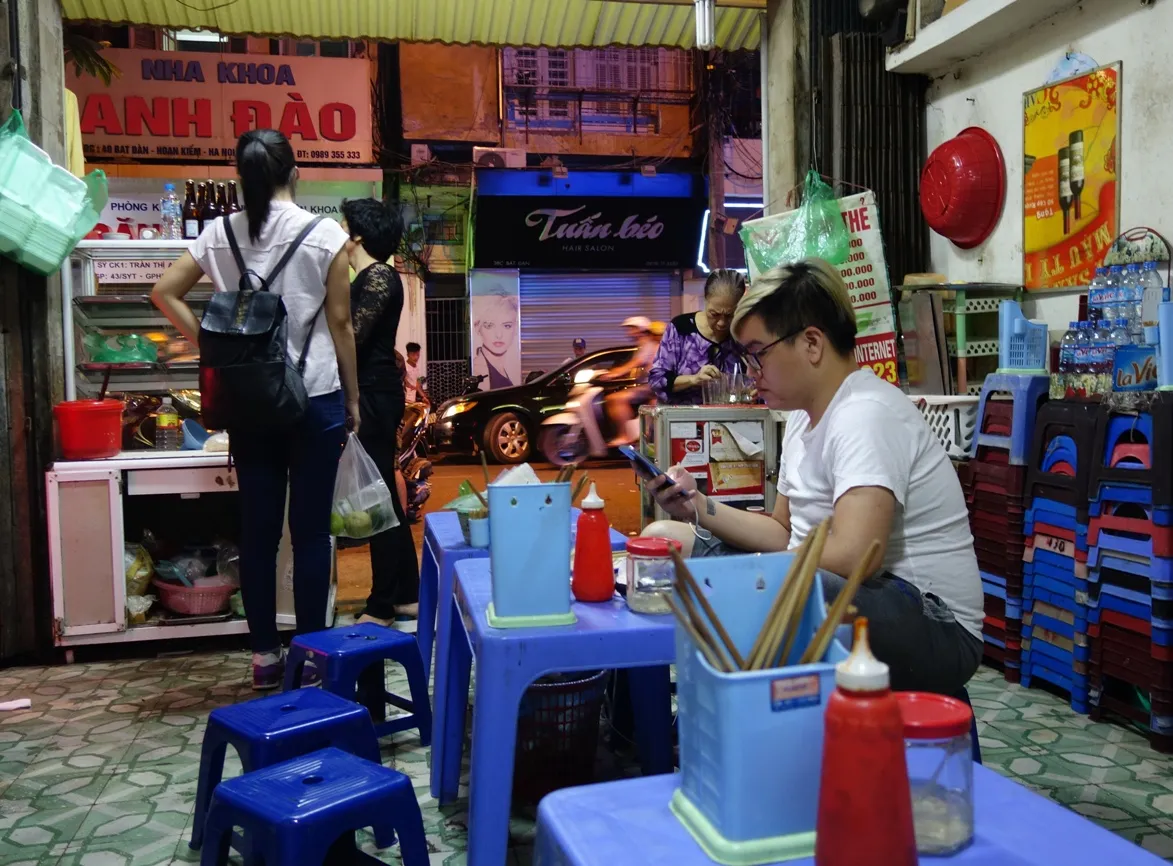 Variety of fresh herbs and leafy greens commonly used as accompaniments for Vietnamese dishes
Variety of fresh herbs and leafy greens commonly used as accompaniments for Vietnamese dishes
Experiencing a Hanoi Walking Food Tour with a local guide provides invaluable context. They can explain why certain dishes are eaten at specific times of the day, the significance of particular ingredients, or the cultural importance of sharing meals. This layer of understanding elevates the experience beyond just tasting food; it becomes a lesson in the city’s rich heritage and vibrant present.
The beauty of a Hanoi Walking Food Tour is its adaptability. While some tours follow fixed routes, others can be tailored to your preferences, dietary needs, or adventurous spirit. Whether you’re keen to try exotic ingredients or stick to popular classics like Bun Cha or Egg Coffee, a good guide can curate an experience that will leave you with lasting memories and a deeper appreciation for Vietnamese cuisine.
Navigating the bustling streets, sitting on tiny plastic stools, and savoring freshly prepared dishes amidst the sounds and smells of the city is an adventure in itself. It challenges your comfort zone in the best possible way, forcing you to engage directly with the environment and its people. This authentic interaction is a key part of what makes a Hanoi Walking Food Tour an essential experience for any visitor.
It’s an opportunity to see how food acts as the lifeblood of the city, nourishing not just the body but also the community spirit. Street food stalls are gathering places, hubs of activity where friends meet, families eat, and the daily news is exchanged. Participating in this ritual, even as a temporary visitor, offers a profound sense of connection to the city’s soul.
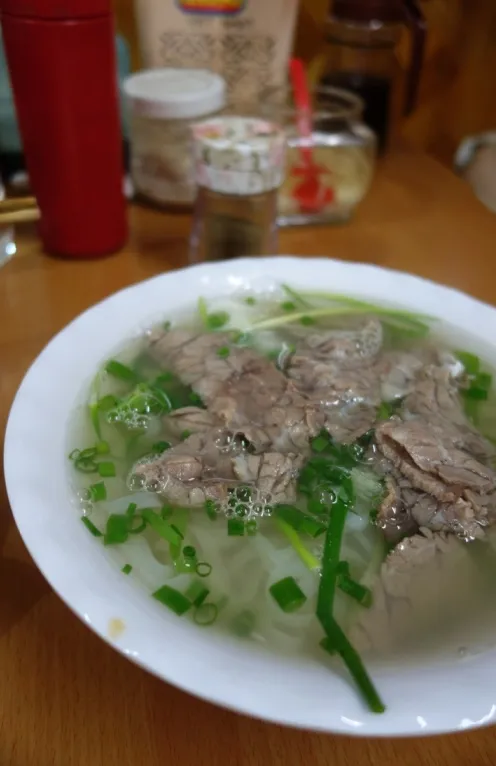 A bowl of dark dessert soup with black beans and a spoon
A bowl of dark dessert soup with black beans and a spoon
A well-planned Hanoi Walking Food Tour ensures you sample a wide variety of dishes without getting overwhelmed. Guides manage the portions and the pace, allowing you to try many different things. They also know which stalls are renowned for specific dishes, saving you the guesswork and potential disappointment. This curated approach maximizes your culinary exploration within a limited time.
The sensory overload of the Old Quarter—the vibrant colors, the pungent aromas, the constant noise—is an integral part of the food tour. It’s a full-body experience that engages all your senses. Each bite of food is amplified by the dynamic environment, making it taste even more authentic and memorable.
Ultimately, a Hanoi Walking Food Tour is an investment in experience. It’s a chance to dive headfirst into the local culture, guided by someone who lives and breathes it. It demystifies the street food scene, making it accessible and enjoyable. For anyone visiting Hanoi, putting on comfortable shoes and embarking on this culinary adventure is highly recommended. It’s the best way to truly taste the city.
Frequently Asked Questions About Hanoi Walking Food Tours
What is a Hanoi Walking Food Tour?
A Hanoi Walking Food Tour is a guided excursion, typically lasting several hours, that takes participants on foot through areas like the Old Quarter to sample various street food and local dishes at different stalls and small restaurants.
What kind of food can I expect to eat?
You can expect to try a wide variety of Vietnamese street food classics and regional specialties such as Pho (noodle soup), Banh Xeo (savory pancake), Bun Cha (grilled pork with noodles), spring rolls, various salads, desserts, and unique local dishes like Egg Coffee or possibly even more adventurous items like frog or snakehead fish.
Is a guide necessary for a Hanoi Walking Food Tour?
While you can explore on your own, a local guide significantly enhances the experience. They navigate the complex streets, translate menus, explain the history and cultural significance of the dishes, help you avoid potential scams, and ensure you try the best versions of each dish from reputable stalls.
How long do Hanoi Walking Food Tours typically last?
Most guided Hanoi Walking Food Tours range from 2 to 4 hours, providing enough time to visit multiple locations and sample a good variety of food without feeling rushed.
What is the best time of day for a Hanoi Walking Food Tour?
Evening tours are popular as the street food scene comes alive, offering a vibrant atmosphere. However, morning or lunchtime tours are also available and might offer different dishes popular during those times, like Pho for breakfast.
Are Hanoi Walking Food Tours suitable for vegetarians or those with dietary restrictions?
Many tour operators can accommodate dietary needs, including vegetarian or vegan requests, if informed in advance. However, options might be more limited compared to the full tour. It’s best to check with the tour provider beforehand.
How much does a Hanoi Walking Food Tour cost?
Costs vary depending on whether it’s a group or private tour, the duration, and the number of food stops included. Generally, prices range from $20 to $50 USD per person, with private tours being more expensive. This usually includes all the food sampled.
What should I wear and bring on a Hanoi Walking Food Tour?
Wear comfortable walking shoes as you will be on your feet for several hours. Light, breathable clothing is recommended, especially in warmer months. Bring a small bag for essentials, bottled water, and maybe some hand sanitizer. Cash is essential as many street vendors only accept local currency.
